Authentic German Sauerbraten
This post may contain affiliate links. See my disclosure policy.
One of Germany’s national dishes, this authentic German Sauerbraten features beef roast that is marinated, cooked until fork tender, and served with a wonderfully rich and flavorful sweet-tangy gravy! Serve it with the traditional sides of Rotkohl, potatoes, Semmelknödel, Kartoffelklöße, or Spätzle for a hearty and thoroughly satisfying and unforgettable meal. And whether you’re serving it for a special occasion, casual family gathering, or as part of your Oktoberfest dinner, you’re all set for a memorable feast!
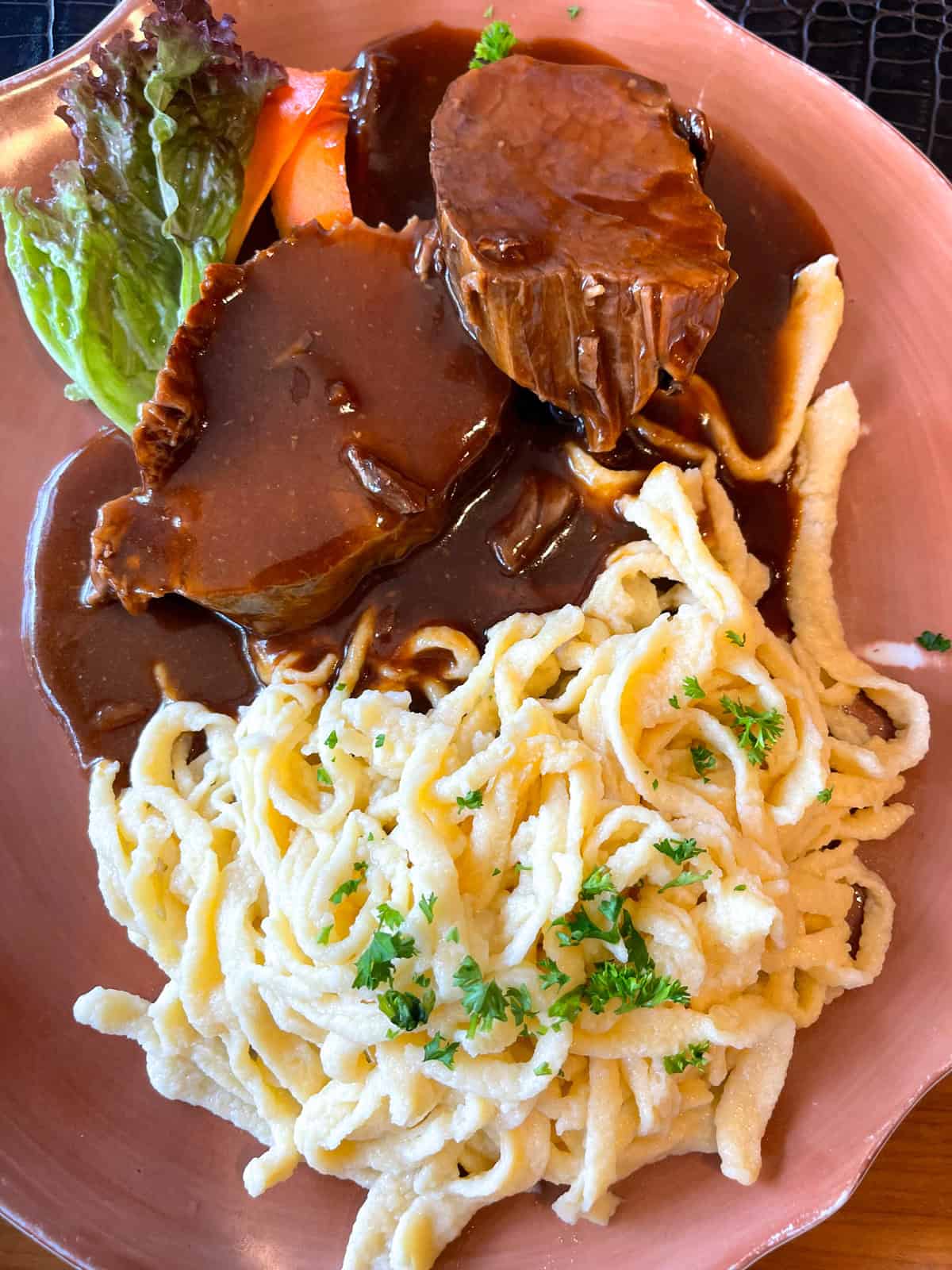
Growing up in southern Germany until moving to the U.S. in my mid-20’s, Sauerbraten was a dish I frequently enjoyed and always looked forward to. Both my Mutti and my Oma would make it served with Rotkohl and either Semmelknödel or Kartoffelklöße, sometimes Spätzle, and it was a memorable feast every time. It was also a dish we enjoyed ordering at restaurants, with each region of Germany adding their own touches and variations.
What is Sauerbraten?
Sauerbraten is a traditional German beef roast that is marinated, browned, and slow-cooked. It is marinated in a mixture of vinegar, wine, spices and herbs over the course of several days which tenderizes the meat and infuses it with its characteristic tangy flavor (hence the name sauerbraten, the German word for “sour roast”).
Sauerbraten is a dish that definitely requires some advance planning as the roast has to marinate for about a week before it’s ready to cook. Don’t cut corners by shortening the marinating time and or holding back on the marinade ingredients. Prepare that amazing marinade, let the meat marinate fully and then reap the rewards for your patience!
Where Did it Originate?
The origin of Sauerbraten has been ascribed to Julius Caesar who is documented as having sent beef marinated in wine all the way from Rome to the new Roman colony of Cologne. Saint Albert the Great of Cologne was later credited with having popularized the recipe in the 13th century. Originally the dish was most commonly made with horse and there are a few restaurants that still serve it, but today it’s primarily made with beef. Less commonly it’s also made with venison or lamb.
This quintessential German dish is found on the menus of many German restaurants both in and outside of Germany. It has been one of Germany’s most popular dishes for generations and as such has become one of its official national dishes.
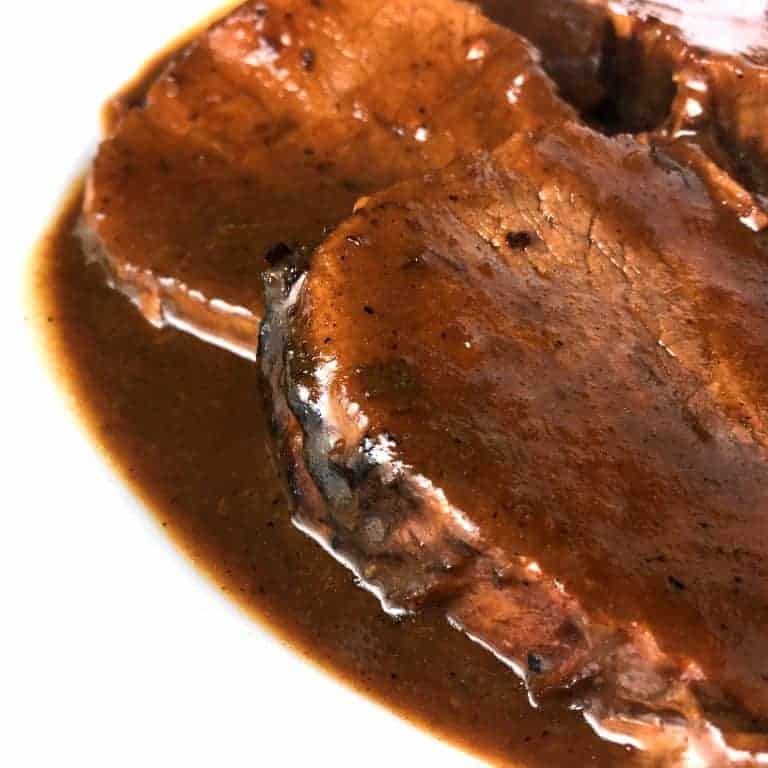
Sauerbraten Ingredients
Sauerbraten recipes vary by region, each adding their own touches. In addition to the sour component there is always the addition of sweet ingredients to balance the acidity and sourness of the sauce. Some regions do this by adding Lebkuchen or ginger snap cookies, raisins, sugar, honey or sugar beet syrup (or often a combination of them) to achieve that balance. To make this traditional Sauerbraten recipe you will need:
- Vegetables: Yellow onions, carrots, leek and garlic go into the marinade and will later be cooked along with the sauce. The leek contributes a fabulous authentic German flavor to the dish so however you may be tempted to omit it, I strongly recommend including it.
- Herbs and Spices: Thyme, rosemary, bay leaves, juniper berries, cloves, peppercorns, salt and sugar all contribute to that authentic Sauerbraten flavor. Juniper berries are very traditional in German cooking, particularly with beef dishes. They contribute a unique woodsy, piney flavor that can’t be replicated any other way. You can buy them online. While I do recommend using them, you can omit them if you can’t find them.
- Red Wine: This forms the bulk of the marinade along with the red wine vinegar. You don’t need an expensive wine because any subtle flavors will be lost in all the seasonings. Choose an inexpensive table wine (but avoid “cooking” wines). Good choices include cabernet sauvignon, merlot or pinot noir.
- Red Wine Vinegar: This creates the “sour” component in Sauerbraten.
- Beef Roast: Tougher cuts like bottom round or rump roast are traditional but you can also use chuck roast for a fall-apart pot roast version.
- Bacon: This is optional and while some variations include it, many do not. I like to include it because that savory-smoky flavor element is fabulous in the final dish.
- Raisins: The inclusion of raisins varies by the region of Germany. Where I’m from in Southern Germany raisins are not included but I occasionally add them because they contribute a really nice flavor and sweetness.
- Ginger Snap Cookies: In Germany things like Lebkuchen or Honigkuchen are traditionally added. Ginger snaps make a great substitute. This adds flavor complexity and sweetness to the dish and also serves as a thickener.
- Honey: This adds sweetness to balance the acidity of the vinegar. Some regions of Germany traditionally use sugar beet syrup instead.
- Flour: To thicken the gravy.
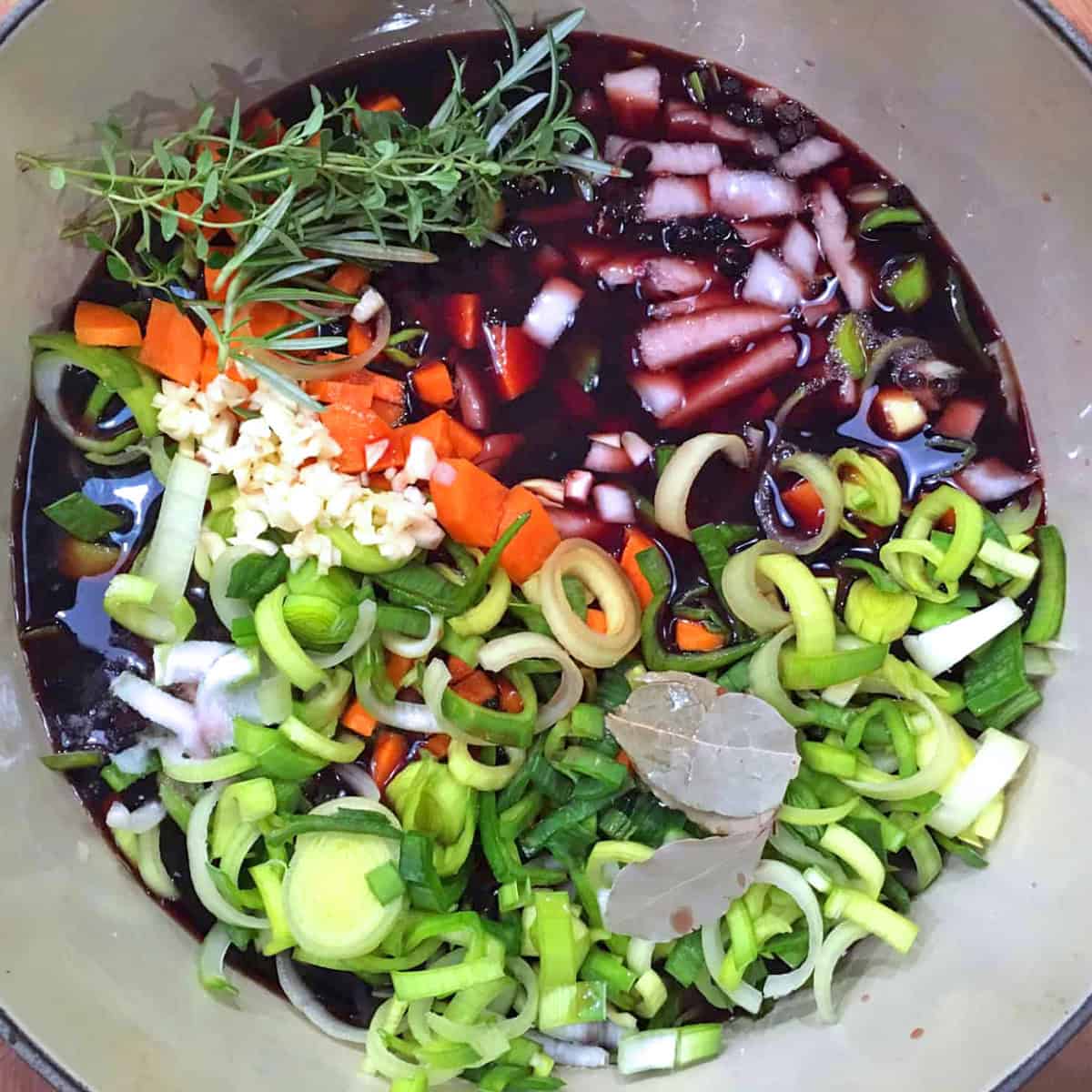
Sauerbraten Recipe
Let’s get started!
Place all of the veggies and herbs in a heavy stock pot or Dutch oven along with the garlic, juniper berries, whole cloves, bay leaves, salt, sugar and peppercorns. Add the red wine, red wine vinegar and water.
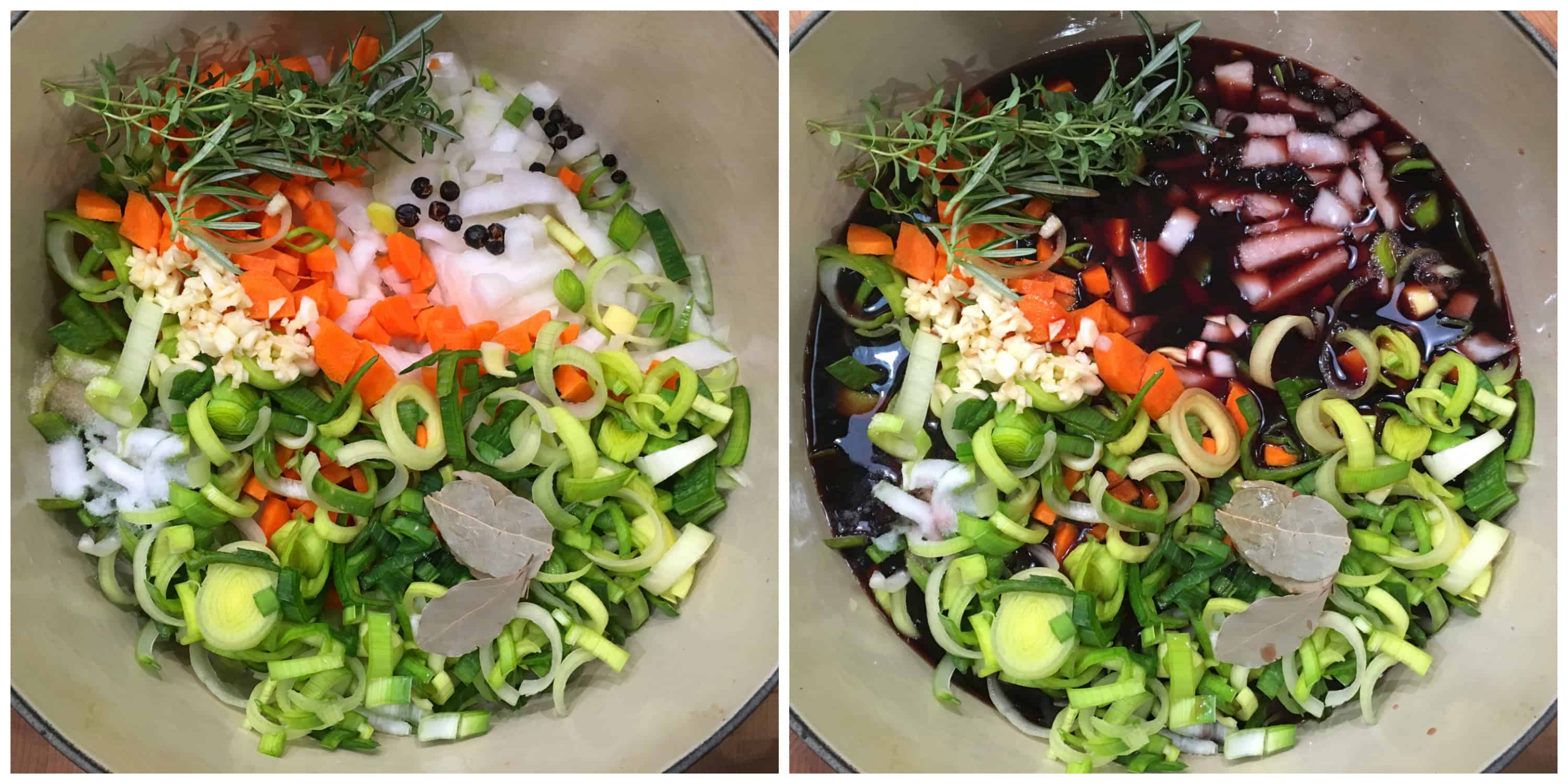
Bring the mixture to a boil, reduce the heat, cover and simmer for 10 minutes. Turn off the heat and let the mixture cool down completely. Nestle the roast in the vegetable marinade and place the lid on the pot.
Let it marinate in the fridge for at least 4 days, preferably 7. (Traditionally, the marinating time is as long as 2 weeks!) Unless the meat is completely submerged under the liquid, turn the roast over once every day.
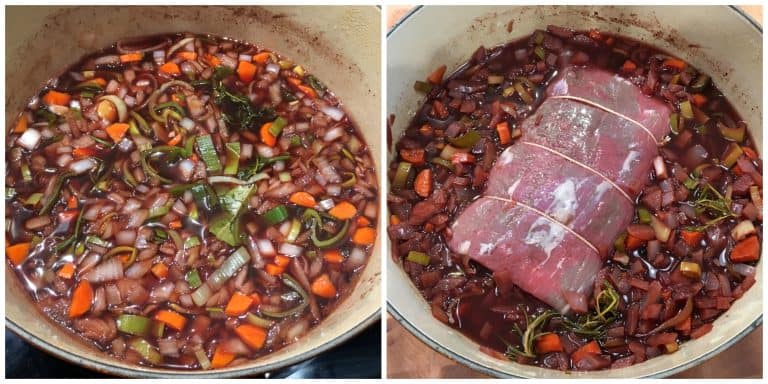
Remove the roast and strain the liquid from the vegetables. Reserve the liquid and the vegetables.
Pat the roast dry with paper towels.
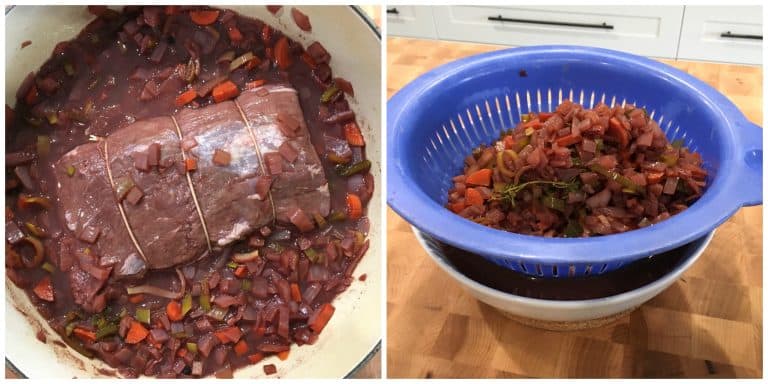
Rinse the pot out and heat a tablespoon or two of oil in it over high heat. Generously brown the roast on all sides.
Remove the roast and set aside. If using bacon, fry the bacon until done.
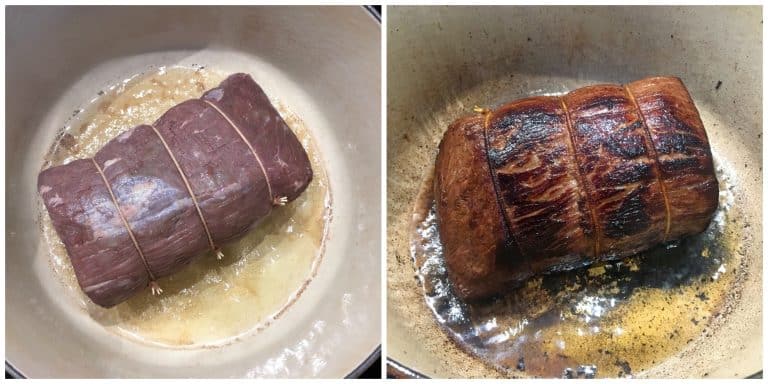
Leave about 2 tablespoons of the oil/fat in the pot. Place the strained vegetables in the pot (along with the bacon if using) and cook for 5-7 minutes. Stir in the flour, cooking the mixture for a minute or two to eliminate the flour flavor. Add the liquid that you strained from the vegetable marinade, bring it to a boil, stirring constantly to prevent lumps.
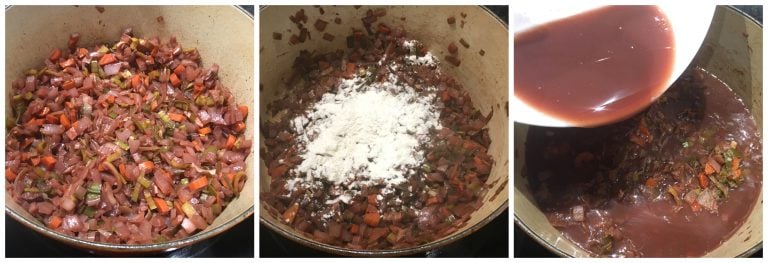
Add the raisins, honey and crushed ginger snaps. Return the roast to the pot.
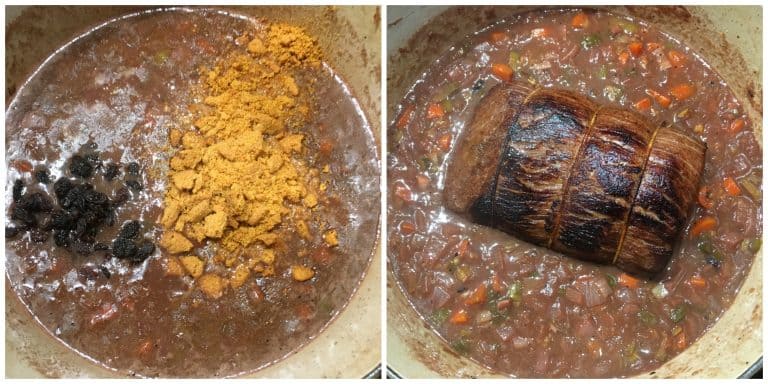
Bring to a boil, reduce the heat to low, cover and simmer for 2-4 hours or until the meat is very tender. Cooking time will vary depending on the type of roast and how long the roast marinated. It takes a while for the tough connective tissues in the meat to get up to temperature to start breaking down, so if the beef isn’t tender continue cooking it.
Note: The longer you let the roast marinate the faster it will cook because the meat will be more tender from the start. So check on your roast periodically for doneness.
When the roast is done, remove and transfer it to a plate and let it rest for 5 minutes before slicing. In the meantime, strain the gravy.
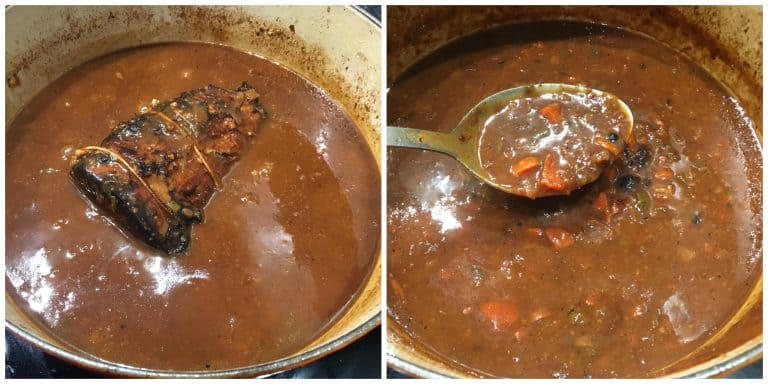
Strain the gravy and return it to the pot. Taste and more sugar, salt and pepper as desired. If you want your gravy thicker, make a cornstarch slurry to thicken the gravy.
Note: The balance of sour to sweet is a matter of personal taste – adjust the flavor according to your preference. If the flavor is too strong for you, you can also dilute it with a little water or broth.
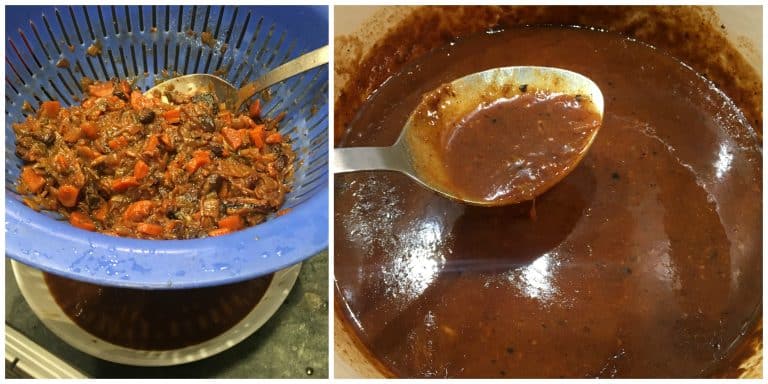
Let the roast rest for 5 minutes after removing it from the pot. Then slice the roast.
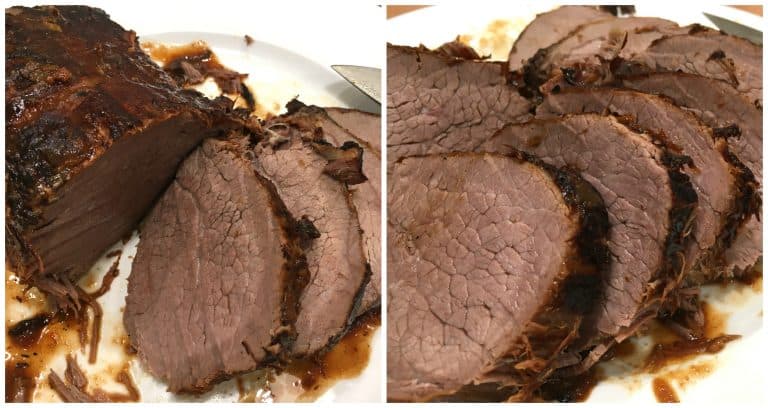
Spoon the hot gravy over the sliced Sauerbraten and serve immediately.
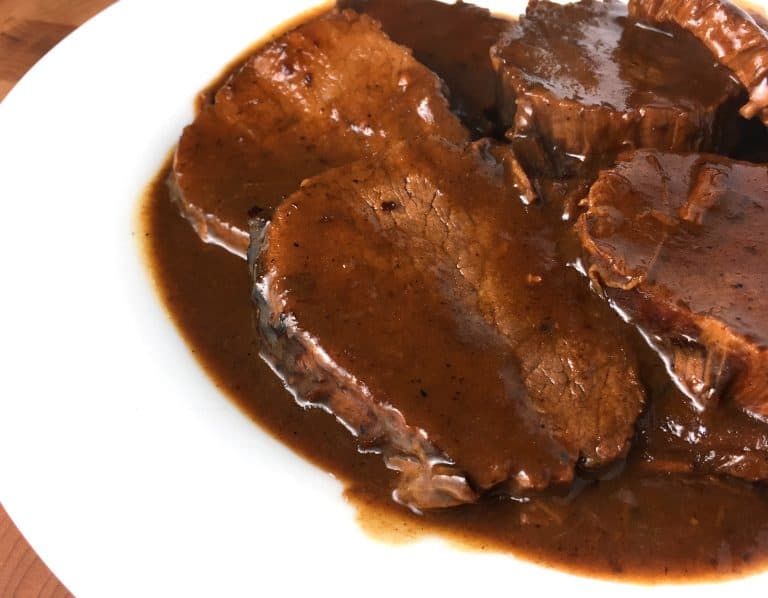
What to Serve with Sauerbraten
There are several traditional sides you can serve with Sauerbraten. These include:
- Kartoffelklöße – these are German potato dumplings and they are popular throughout every region of Germany. They’re made from potatoes and are pillowy soft, making them perfect for mopping up that luscious gravy.
- Semmelknödel – another traditional dumpling, these are bread dumplings seasoned with herbs. These are especially popular in southern Germany where they originated but are served throughout the country.
- Spätzle – the famous noodles from the Swabia region of southern Germany (where I’m from), and when you’re in Baden-Württemberg and order Sauerbraten this is the most popular accompaniment.
- Kartoffelpuffer – where I’m from in Swabia these German potato pancakes are served with sweet accompaniments but in other regions, such as Rhineland-Palatinate, they’re also served as accompaniments to savory dishes, like sauce-based meat dishes. In the case of Sauerbraten, I would serve them in addition to one of the dumpling options or Spätzle.
- Boiled or mashed potatoes – not as exciting as the options above but still perfectly acceptable :)
- Rotkohl – this braised German red cabbage is a must. It is the quintessential traditional side for roast beef in Germany.
- German Potato Salad – definitely the Swabian or Bavarian oil-and-vinegar potato salad varieties, not the mayo-based kind.
- Creamy German Cucumber Salad or the vinegar-based German Cucumber Salad (Gurkensalat) – either of these make a really nice and refreshing accompaniment.
- German Tomato Salad (Tomatensalat) – another refreshing option.
- Bohnensalat – a refreshing green bean salad.
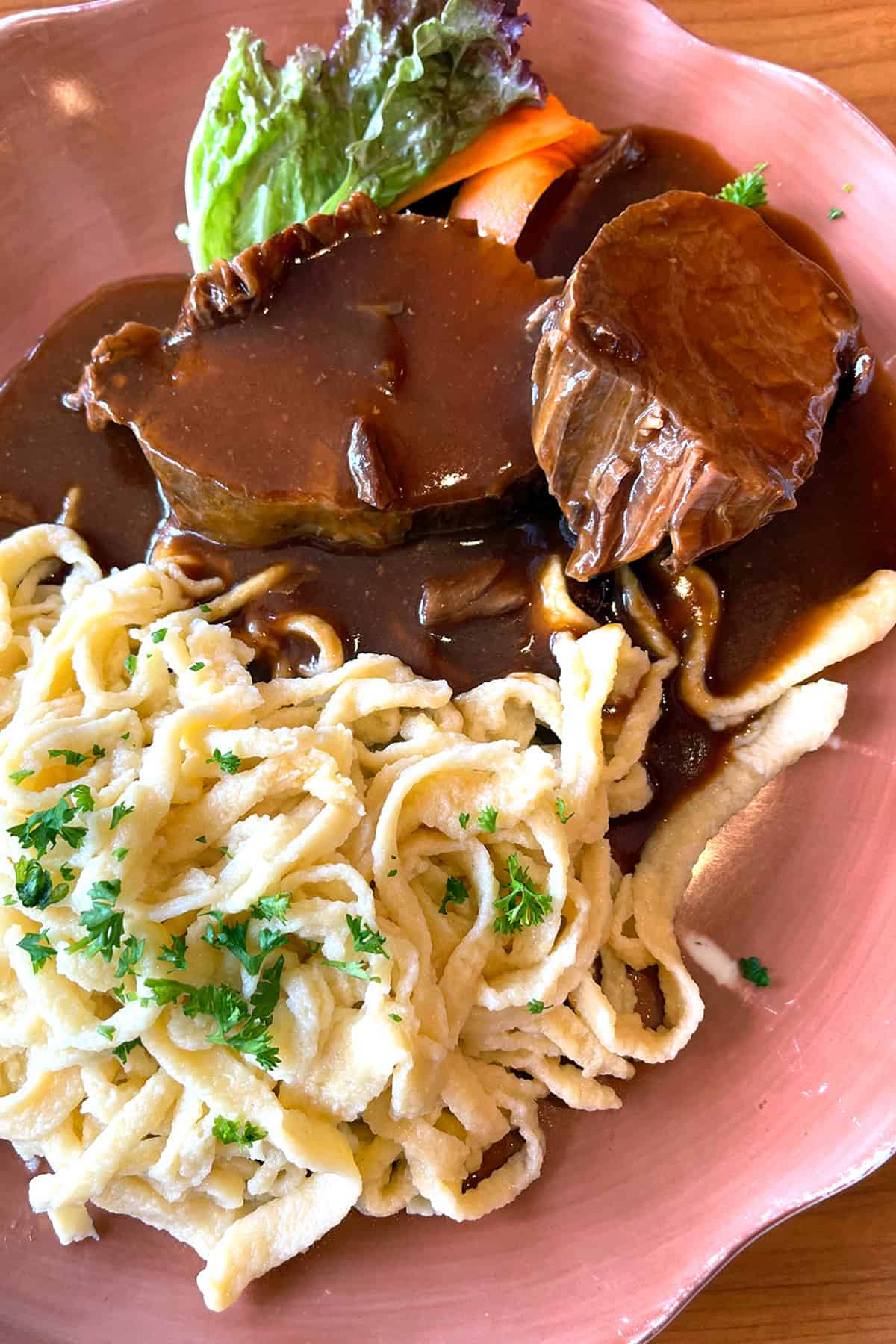
Storage and Reheating
Sauebraten can be made in advance and reheated. I like to pre-slice the meat and store it in some of its gravy to preserve moisture, and then reheat it along with the remaining gravy to serve at the table. It will keep in the fridge for 3-4 days and can be gently reheated in the microwave in a covered container, on the stovetop, in a crockpot, or in the oven.
Sauerbraten can also be frozen. Pre-slice the roast, let it fully cool, and freeze it with the gravy in a freezer-safe container for up to 3 months. Let it thaw slowly in the refrigerator and then gently reheat.
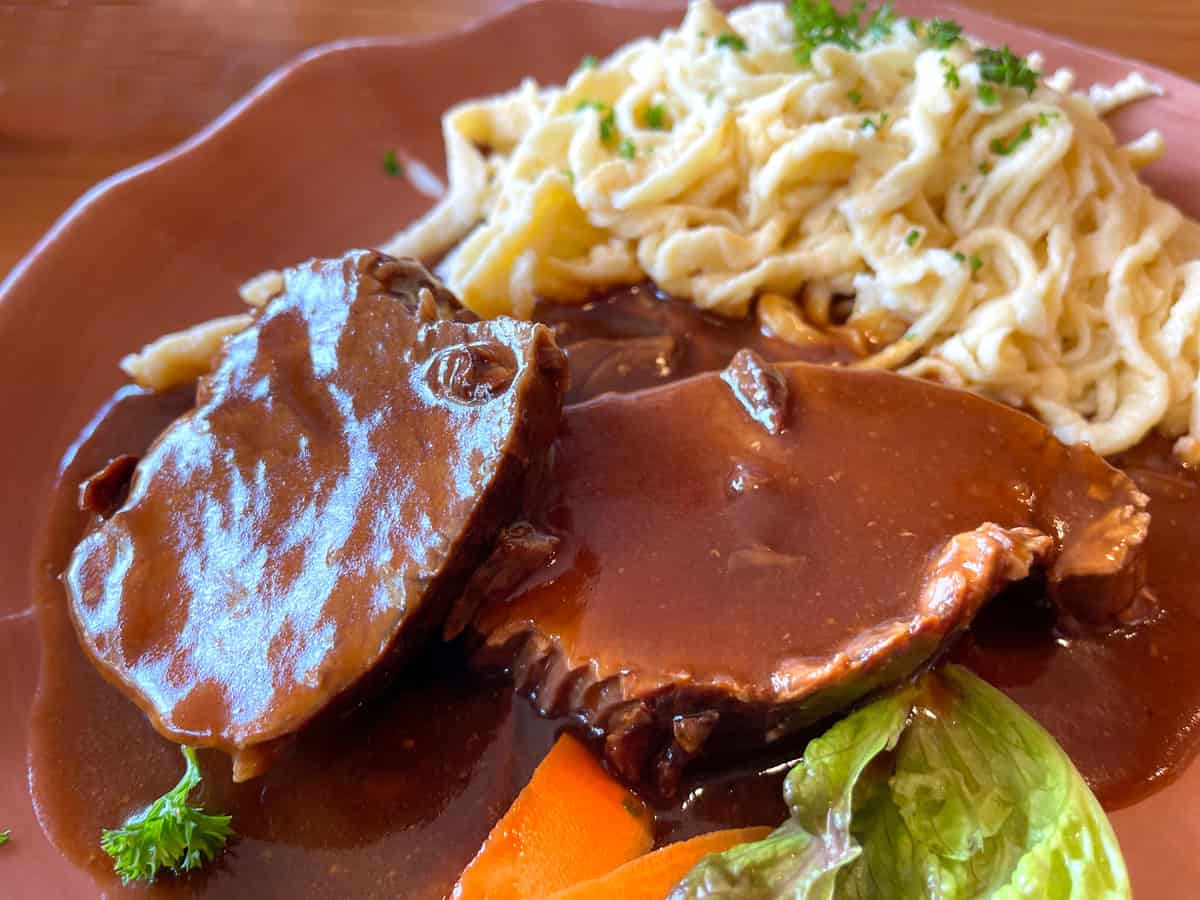
For more delicious German recipes be sure to try my:
- Schnitzel
- Jägerschnitzel
- Königsberger Klopse
- Senfbraten
- Schweinshaxe
- Maultaschen
- German Potato Soup
- Frikadellen
- Currywurst
- Käsespätzle
- German Sauerkraut Soup
- German Bread (Vollkornbrot)
Save This Recipe
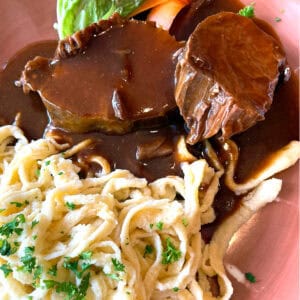
Authentic German Sauerbraten
Equipment
Ingredients
- 2 large yellow onions , chopped
- 2 large carrots , diced
- 1 large leek , chopped, thoroughly washed and drained to remove any dirt
- 3 cloves garlic , minced
- 2 large sprigs thyme , or 1 teaspoon dried
- 2 small sprigs rosemary , or 1 teaspoon dried
- 2 bay leaves
- 8 juniper berries , cracked
- 6 whole cloves
- 10 whole black peppercorns , cracked
- 2 1/2 teaspoons salt
- 1 teaspoon sugar
- 2 1/2 cups dry red wine (e.g., cabernet sauvignon, merlot, pinot noir)
- 1 cup red wine vinegar
- 1 1/2 cups water
- 4 pounds beef roast (tougher cuts like bottom round or rump roast are traditional but you can also use chuck roast)
- 4 slices bacon , finely diced (optional); some variations include but most do not
- 4 tablespoons all-purpose flour
- 1/4 cup raisins
- 3 ounces ginger snap cookies , crumbled
- 1 tablespoon honey
Instructions
- Prepare the Marinade: Place all of the veggies and herbs in a heavy non-reactive stock pot or enameled Dutch oven along with the garlic, juniper berries, whole cloves, bay leaves, salt, sugar and peppercorns. Add the red wine, red wine vinegar and water.Bring the mixture to a boil, reduce the heat, cover and simmer for 10 minutes. Turn off the heat and let the mixture cool down completely.
- Marinate the Meat: Nestle the roast in the vegetable marinade and place the lid on the pot.Let it marinate in the fridge for at least 4 days, preferably 7. (Traditionally, the marinating time is as long as 2 weeks!) Unless the meat is completely submerged under the liquid, turn the roast over once every day.Remove the roast, pat it dry with paper towels, and strain the liquid from the vegetables. Reserve the liquid and the vegetables.
- Cook the Roast: Rinse the pot out and heat a tablespoon or two of oil in it over high heat. Generously brown the roast on all sides. Remove the roast and set aside. If using bacon, cook the bacon until done. Leave about 2 tablespoons of oil/fat in the pot. Place the strained vegetables in the pot (with the bacon if using) and cook for 5-7 minutes. Stir in the flour, cooking the mixture for a minute or two to eliminate the flour flavor. Add the liquid that you strained from the vegetable marinade, bring it to a boil, stirring constantly to prevent lumps.Add the raisins, honey and crushed ginger snaps. Return the roast to the pot.Bring to a boil, reduce the heat to low, cover and simmer for 2-4 hours or until the meat is very tender. Cooking time will vary depending on the type of roast and how long the roast marinated. (Note: The longer you let the roast marinate the faster it will cook because the meat will be more tender from the start. So check on your roast periodically for doneness.)When the roast is done, remove and transfer it to a plate, tent it to keep warm, and let it rest for 5 minutes before slicing.
- Prepare the Gravy: While the roast is resting, strain the gravy and return the gravy to the pot. Taste and more sugar, salt and pepper as desired. If you want your gravy thicker, make a cornstarch slurry to thicken the gravy. (Note: The balance of sour to sweet is a matter of personal taste – adjust the flavor according to your preference. If the flavor is too strong for you, you can dilute it with a little water or broth.)Spoon the gravy over the sliced Sauerbraten and serve immediately.
- Serve with Rotkohl and boiled potatoes, Spätzle, Semmelknödel or Kartoffelklöße . A few parts of Germany even serve it with Kartoffelpuffer.
Nutrition
Originally published October 2, 2018



















I haven’t had Sauerbraten for soooo long. This looks like the recipe I need to make NOW!
Very good my German mother used buttermilk instead of wine so much milder Sorry.
Hi Kimberly
thanks for the great sauerbraten recipe I make this for all my Scottish friends throughout the winter, A great hit!! Now I wo`nt need to bring suitcase`s full of a popular pre mix sauce M@!!! home with me, will give it a try soon let you know
best
bob
Friendly greetings to Scotland, Bob! Wonderful, I hope you enjoy the fully “from-scratch” version and look forward to the feedback!
I just realized that I haven’t made this in a million years! It’s so good. Thank you for the reminder. Germany is beautiful. Seems like when I was visiting I ate a lot of beautiful trout, although I sampled all of the local foods as well. I had so much white asparagus with schinken and white sauce… spargele? It’s a lovely country.
This far exceeds my cooking skills, but just reading through the recipe brings back so many fond childhood memories. I love your website!
Thank you so much, Ingrid! <3
Please add the name of the dish and your name to your pics, it’s hard to recognize things after a few weeks.
Hi Judy, I’m not sure I understand what you mean, can you be more specific?
My German momma only made this on Christmas Eve. It used to be a real production, lol. Especially the Kartoffelklosse….too much flour, not enough flour, more salt, etc. Talk about stressed out! But, when it finally reached the table, it was pure heaven. My papa loved leftover Kartoffelklosse the next day sliced and fried in a little butter until crispy on the outside and still tender inside. Now my mouth is watering…
Lol, Gudrun, I can imagine! :) But yes, the effort is always worth it. And fried leftover Kartoffelklöße is a fabulous idea, thanks for sharing!
On our first visit to my cousin’s village of Pfullingen, this is exactly what she prepared for our first German dinner after the long journey from SeaTac to Frankfurt and then on the ICE to Stuttgart where they met us and the hour drive to their haus. Fell in love with this meal and am already imaging how good this will be. By the way she makes what I believe is Semmelknödel from rolls I believe called Brotchen that are cubed and dried. The flavor and texture reminded me of a very good Thanksgiving dressing. Will be making this soon as fall has arrived here in the PNW.
Greetings from a fellow Washingtonian, Paul! :) Yes, both Semmelknödel and Kartoffelklöße are traditional sides for Sauerbraten and Semmelknödel as you described are the ones made from dried Brötchen cut into cubes. I’ll be posting my recipe for those shortly. Autumn is the time of year I always start to miss Germany the most and come Christmas time I’m downright homesick. Enjoying good home-cooked German food always helps a little :)
Hi Kimberly,
Love your column! Been following along for awhile and can attest to the authenticity of your recipes; my parents are both from Germany and immigrated to the US, so I grew up with German cooking. For sauerbraten, we have always marinated the meat in buttermilk (with some juniper berries, bay leaves and peppercorns) for 3-4 days, and discarded the buttermilk once done marinating. Then the recipe was pretty much the same as yours, as far as braising the veggies with the meat til tender, etc; never did use any gingersnaps or honey… Of course none of this was written down – all in my head now, since I learned to cook this food from my mom! Keep the recipes coming and thank you!
Thank you so much, Karen, I appreciate the compliment. Yes, these differences (buttermilk, gingersnaps, raisins, etc) all come down to regional variations. Each regions version is a little different but all very good. Thanks again and enjoy the rest of your weekend! Kind regards, Kimberly
Hi Kimberly – thank you for the recipe. I’m looking forward to trying it. Just a quick question – What type of red wine do you use?
Hi Mike, I’ve used a variety of red wines for Sauerbraten and other beef dishes over the years including burgundy, merlot, pinot noir, red zinfandel, cabernet sauvignon, sangiovese, and cabernet Franc – all of them with great results. I’m no wine aficionado but in my opinion you can’t go wrong with any of those options.
How can I pick a favorite? They all look amazing!
Wow how awesome to grow up in Germany! This dish looks so good!
WOW! I have never heard of this before – can’t wait to try it out!
Looks awesome! Such amazing flavors all in one dish, side dishes looks perfect!
This dish looks incredible! I am excited to try the side dishes too!